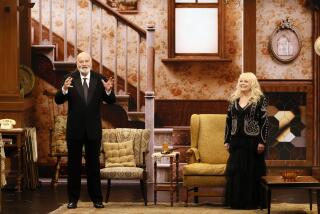After 75 Years, ‘Father of TV’ Gets His Due
- Share via
Even Hollywood’s brightest scribes couldn’t have conceived a story more amazing and inspiring than Philo T. Farnsworth’s. A deeply religious farm boy, he arrives at the idea for transmitting sound and pictures--in other words, television--at 14 while tilling a field in Idaho. Then at age 21, he transmits the first image on a picture tube in his little laboratory in San Francisco.
It’s a story of the underdog who made good, the little guy who took on big business and proved in 1935 that it was he and not David Sarnoff and RCA who was the real “Father of Television.” And it’s also an epic love story.
For the record:
12:00 a.m. Sept. 28, 2002 For The Record
Los Angeles Times Saturday September 28, 2002 Home Edition Main News Part A Page 2 National Desk 4 inches; 164 words Type of Material: Correction
TV inventor--A story in Monday’s Calendar about Philo T. Farnsworth, the “father of television,” mistakenly said the first picture tube was the size of a postage stamp. It was the first transmitted picture that was the size of a postage stamp.
And finally, on the 75th anniversary of his remarkable discovery, the Academy of Television Arts & Sciences celebrated Farnsworth’s legacy Sunday night during the 54th annual Emmy Awards. The recognition is long overdue considering that there may not have been an Emmy Award without Farnsworth’s invention.
Farnsworth died in 1971, but his 94-year-old widow and collaborator, Elma “Pem” Farnsworth, has been keeping his legacy alive and well. She flew to Los Angeles on Saturday--with her nurse, Kathy Stump--from her home in Fort Wayne, Ind., to attend Sunday’s festivities.
Pem Farnsworth, who penned the memoir “Distant Vision: Romance and Discovery on an Invisible Frontier” 20 years ago, joked that she won’t be wearing anything low-cut to the Emmy Awards, just a black-lace blouse and skirt. The mother of four, grandmother of eight and great-grandmother of nine, was set to attend the Emmys with her longtime friend Georja Skinner, who is also her manager and publicist.
During her visit to Los Angeles, Pem Farnsworth also planned to visit the site of the couple’s original “lab”--actually their apartment--in Los Angeles, accompanied by television historian Paul Schatzin. His biography of Farnsworth, “The Boy That Invented Television,” was published on Sept. 7--the 75th anniversary of the first television transmission.
Skinner said that she and her family have been trying to get more recognition for Philo Farnsworth for the last two decades. “I have been in touch with the family off and on for a long time, and it really seemed things were heating up around the 75th anniversary.” Through the help of her friend, former Directors Guild of America President Jack Shea, Skinner contacted the television academy this year and convinced them that a Farnsworth tribute was long overdue.
Naturally, Pem Farnsworth is excited about the tribute. She says it is God’s will that she attend.
“I belong to a religion commonly known as Mormon, and [we] are taught when we are prompted to do something, we don’t ask why. We just do it. I got prompted and I am going.”
In 1926, she says, her husband told his backers that if they would give him $25,000 he would have a picture transmission in one year. “Anyone who has any technical experience or read about it knows that was a foolish thing to say, but he used to say to me, ‘We are on a guided tour [in life],’ so he didn’t question it, he just did it.”
Other inventors were also working on television models, but they were attempting a “mechanical spinning disc-type thing,” Farnsworth says. “But he had just learned what made electricity, and he was fascinated by the electron. That was the only thing fast enough to use in television.”
The first picture tube was about the size of a postage stamp. “It was only one dimension because, well, he had promised a picture in a year and he hadn’t promised anything more than a picture,” Farnsworth says. “He realized that he was up against a lot of money by other people who were working on television. He just had to go by the inspiration because otherwise he was not going to be able to do this.”
In addition to several biographies on Farnsworth, the inventor and Pem play an important part in the acclaimed 2001 historical novel “Carter Beats the Devil,” by Glen David Gold.
Skinner says several Hollywood producers are interested in Farnsworth’s story. “Pem wants one feature film about this story,” Skinner says. “That would be her dream. She has been waiting a really long time.”
More to Read
The complete guide to home viewing
Get Screen Gab for everything about the TV shows and streaming movies everyone’s talking about.
You may occasionally receive promotional content from the Los Angeles Times.







